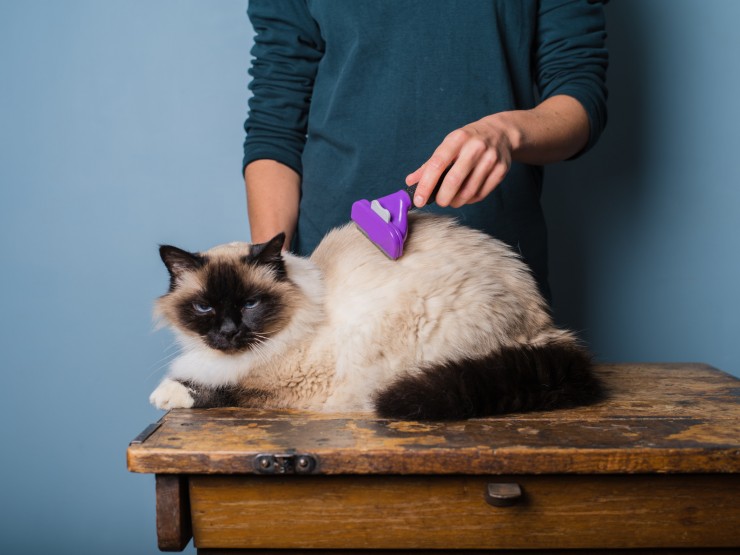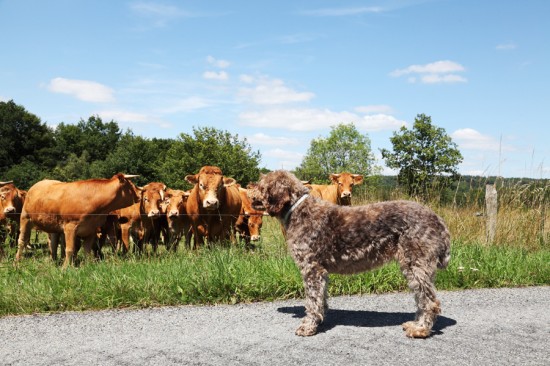
Dogs and cats get plaque on their teeth just like we do! Plaque
is made of proteins (from saliva) and bacteria. If the plaque is
not removed every day the bacteria will multiply rapidly and
invade the gums around the teeth. Gingivitis, or inflammation of
the gums, results. If the plaque is still not removed the
inflammation of the gums will spread to the bone around the
teeth and cause bone loss or periodontal disease. Ultimately,
the teeth have no bony support and may become loose or even fall
out.
Fortunately, gingivitis is reversible and periodontal disease is
preventable! When plaque is removed by tooth brushing the gums
and bone around the teeth will stay healthy. If plaque is not
removed calculus or “tartar” will form when minerals from saliva
cause the plaque to harden. Once calculus is present, a
professional cleaning is needed to remove it. You can prevent
calculus from forming by removing plaque every day with tooth
brushing.
Tooth brushing should be introduced gradually. Don’t force your
pet’s mouth open. Start by just sliding your finger under the
cheek and running your finger along the teeth and gums. Do this
every day for about a week, and always praise your pet during
and afterwards, or give her a favorite toy when you are
finished. When she is used to this, begin using a soft-bristled
toothbrush and pet toothpaste. (Human toothpaste contains
foaming agents that can upset your pet’s stomach. Fluoride is
also not needed as dogs and cats don’t usually get the same kind
of cavities people do.) The paste should be pressed down into
the bristles so the pet doesn’t lick it off the brush. Start by
brushing just a few teeth at a time. Hold the toothbrush at a
45′ angle so the bristles go under the gumline. Only the outside
surfaces of the teeth need to be brushed at first. Try to use a
circular motion with the toothbrush if at all possible.
Brushing should be done at the same time every day so it becomes
part of your pet’s daily routine. Afterwards, give a reward such
as a favorite toy, a walk, or lots of praise. Most dogs and some
cats will actually learn to enjoy this daily ritual and will see
it as extra attention from their favorite person.
Chewing activity: dogs that are active chewers are less likely
to have plaque build-up. Chew toys such as Kong® toys, Plaque
Attackers®, Gumabones®, or rawhide are recommended. Hard plastic
bones, fresh bones, cow hooves, and sterilized real bones are
too hard and may cause tooth fractures. Edible treats are often
eaten too quickly to be of much benefit and may add significant
calories to the diet.
Special diets: Hill’s T/D diets, available through veterinarians
for dogs and cats, and Friskies Dental Diet for cats help reduce
plaque build-up, too. These are nutritionally complete so they
can be fed as a maintenance food or can be used as treats if
your pet is on a special diet.
The above is general veterinary information. Do not begin
any course of treatment without consulting your regular
veterinarian. All animals should be examined at least once every
12 months.
 Retraining The Delinquent Horse
Retraining The De
Retraining The Delinquent Horse
Retraining The De
 Finding Out More About The White German Shepherd Or White Shepherd Dog
Finding Out More
Finding Out More About The White German Shepherd Or White Shepherd Dog
Finding Out More
 Tips On Keeping Cat Hair Under Control Around The House
Tips On Keeping C
Tips On Keeping Cat Hair Under Control Around The House
Tips On Keeping C
 Give your interior a new look with Aquarium
Give your interior a new look with Aquarium
If
Give your interior a new look with Aquarium
Give your interior a new look with Aquarium
If
 Understanding Your Dogs Behaviour
Understanding You
Understanding Your Dogs Behaviour
Understanding You
Copyright © 2005-2016 Pet Information All Rights Reserved
Contact us: www162date@outlook.com